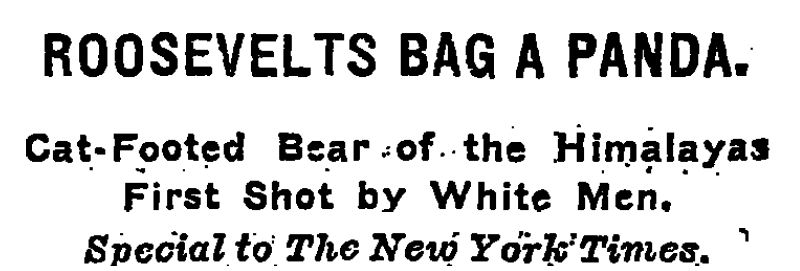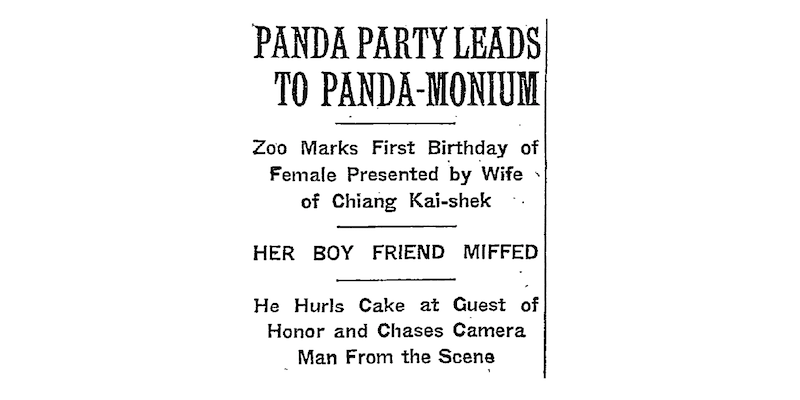How America Fell in Love With the Giant Panda
A French missionary, Teddy Roosevelt’s sons, and a widowed socialite all factor into the tale of how the nation fell in love with the rare beast
/https://tf-cmsv2-smithsonianmag-media.s3.amazonaws.com/filer/5c/96/5c96803e-ab9d-4688-9532-73501259292f/milne-edwards_panda.jpg)
On a chilly Wednesday in 1936, the day before Christmas Eve, a giant panda appeared in New York City. Its name was Su Lin. Two months earlier, the animal had been plucked from its jungle home, wailing, and swept halfway around the planet on airplanes and sea ships, wrapped inside blankets and baskets. No panda had ever survived a trip outside of East Asia. In the weeks before Su Lin's arrival, American newspapers reported each detail, every nugget of news, about his trip across the Pacific.
From the first moment Su Lin was carried out into Grand Central Station and reporters instantly trumpeted the news of America's first panda, celebrity clung to his coat. He clung too: to Ruth Harkness, a widowed socialite-turned-explorer, who went to China without any wilderness experience, vowed to complete her late husband’s hunt for a panda, and returned triumphant, nursing Su Lin from a baby bottle filled with instant milk. Harkness's journey sparked a "happy furor" across the country, as biologist George Schaller described in his book, The Last Panda.
It was the moment America fell in love with the giant panda.
The New York Times announced the news in a delightfully informative headline, "BABY PANDA HERE, ENJOYS ITS BOTTLE." As Harkness held court at the Biltmore Hotel, a brisk December breeze drafting through open windows "to preserve the native Tibetan climate," journalists gawked at the cub. "What they saw bore a threefold resemblance to a sucking pig, a tiny lamb, and a puppy" the Times reported. "Its general coloring is white, but its ears are black and it had tiny black-rimmed eyes, dark brown paws and legs and a brown belly. It is about eighteen inches long and weights a little more than ten pounds." The photo that accompanied the article was one of the first of a live panda ever published in a newspaper.
***
It may seem like a modern reaction, the cooing and the fawning and the aww-ing over cute animals — this website is no stranger to the art of leveraging panda cub photos for squee-hungry readers — but it’s far from a contemporary trend. The first panda craze gripped the United States in the early 20th century, sparked by Harkness, and ballooned into a cultural phenomenon by the end of the 1930s. Explorers raced to China to capture pandas, then sell them for a small fortune. Zoos competed to host their own exhibits, eager to attract the paying crowds that were guaranteed to come. A giant panda was as good as gold. Within six months of his debut, for instance, Su Lin drew more than 300,000 people to suburban Chicago’s Brookfield Zoo. Everyone from Helen Keller to Al Capone couldn't resist the chance to visit a panda.
This story, however, doesn't start with Su Lin, or with Harkness.
It starts with a 19th-century Lazarist priest named Armand David. In the 1860s, he worked as a missionary in China, where he studied hundreds of species of birds and animals. It was there, in March 1869, that a hunter brought him the skin of a young giant panda. No westerner had ever seen, as David wrote, evidence of the "black and white bear." He arranged to send a skin specimen back to Paris, where it still remains, and wrote to French mammalogist Alphonse Milne-Edwards with glee: "I have not seen this species in the museums of Europe and it is easily the most pretty I have come across; perhaps it will turn out to be new to science!" (Milne-Edwards was the man who, years later, proposed that the panda was related to raccoons, not bears.)
In the decades after David brought news of the panda back to Europe, though, sightings remained few and far between. Even art depicting pandas was rare, according to Stephen Allee, associate curator for Chinese painting and calligraphy at the Freer and Sackler galleries. Schaller notes several cases in The Last Panda: a botanist named Ernest Wilson noted "large heaps of its dung" in 1908, but didn't spot their source; British explorer J.W. Brooke claimed his hunting party shot a "parti-coloured bear" the same year, though he was killed by locals before he was able to explain further; and in 1916, a German zoologist named Hugo Weigold purchased a cub, which died soon after. By 1919, when the American Museum of Natural History exhibited its first mounted specimen, the truth couldn't be denied: pandas were out there, they were unlike any animal seen in America or Europe, and the first people to bring one to the west would be met with unfathomable fame.
Unless they already were famous. In May 1929, Teddy Roosevelt's sons, Kermit and Theodore Jr., became the first Westerners known to shoot and kill a giant panda. Their hunt was, in true Roosevelt fashion, something between sport and science; reports from the era claim they spent more than $10,000 on the ten-month trip through India, China, and Tibet, which was organized on behalf of Chicago's Field Museum. The panda they shot, along with another killed by a local hunter, are still on display at the museum today.

The press followed the exploits of their hunt with relish. "ROOSEVELTS BAG A PANDA. Cat-Footed Bear of the Himalayas First Shot By White Men," the Times announced in a headline. Each brother took a victory lap upon return to the States, too, with extensive interviews about their accomplishment. "We were extremely lucky, as a matter of fact, for after only four hours of tracking we discovered the beast taking its noonday siesta," Kermit said, apparently confusing East Asia with Latin America. "My brother and I approached carefully, fired simultaneously and got him. The [hired locals] with us refused to bring the animal into their village. It seems the giant panda is a sort of minor deity among them." They even wrote a book, Trailing the Giant Panda, in response to the public's demand.
From that point forward, the race was on. An eclectic collection of adventurers, including actor Douglas Fairbanks, struck out to China in search of giant pandas. Their expeditions led to an unprecedented number of collected specimens—by 1936, roughly a dozen were exhibited in museums—but still, no one had brought a living panda to the west. Until Ruth Harkness gave it a try.
When Su Lin arrived in the United States, newspapers didn't hesitate to relay every scintillating detail of Harkness's journey. In 1934, her husband William, shortly after marrying Ruth, had travelled to China and his attempts to capture a panda were stymied by permit issues. A year later, as he waited for bureaucratic approval from the Chinese government, William fell ill with cancer. He died shortly thereafter, without ever beginning his hunt. That's when Harkness decided to realize her husband's dream. "I inherited an expedition, and what else could I do?" she later explained.
The trip had no shortage of scandals, to the delight of the press. Nearly every story about her expedition makes mention of Quentin Young, a 22-year-old Chinese naturalist, with whom she had a secret affair. Floyd Tangier Smith, a rival panda hunter who worked with her husband, claimed that Harkness didn't find the cub in the jungle, but instead, bought him from Chinese hunters. (She and others rigorously denied the charge.) Later, when she tried to sail back to America, custom officials detained her; the spat would ultimately be resolved after the state levied a $20 tax for "one dog." By the time newspapers actually had an opportunity to photograph Su Lin, Harkness's story was already the stuff of gossip legend.
After Harkness sold Su Lin to the Brookfield Zoo in 1937, months after her return, massive crowds rushed to gawk at the never-before-seen animal. By the end of the decade, six more pandas would be imported to American zoos: two more at Brookfield, two at the Bronx Zoo, and two for the Saint Louis Zoo. Each brought a new round of goofy press coverage. When that second panda arrived at the Bronx Zoo, in May 1939, the Times published details about the animal's mid-air tantrum: "Chained in the rear of the pilots' cabin out of Kansas City, Bimbo lunged at M.H. Kassing […] according to Captain Don Terry, pilot of the plane, the panda tore out part of the trousers seat of Captain D.H. Tomlinson." The pandas were top attractions in all three zoos; one from the Bronx Zoo was even loaned out to headline the World's Fair.

Pandas were, and still are, big business. That's why whenever a panda died, the three zoos would rush to find a replacement as soon as possible. Between the late 1930s and early 1940s, a common pattern emerged: the old panda would be mourned, the zoo would announce it had purchased a new panda, and press coverage would erupt once the panda arrived. The pinnacle of the trend is this Times story about panda birthday party: "The boy panda, perhaps because his birthday passed unheralded, took over the party […] He climbed into his chair, up onto the table and sat on the cake. Then he began throwing pieces of cake at the guest of honor. Both ate a little."
By the early 1950s, though, the Cold War made it difficult for zoos to import animals from China. The number of pandas in America had dwindled to zero: Su Lin and two others, Mei-Mei and Mei-Lan, had died at the Brookfield Zoo; the Bronx Zoo's four were dead; and the Saint Louis Zoo had recently mourned its last one, Pao Pei. In May 1958, when a panda was up for sale in Peiping, the federal government made clear that it wouldn't be allowed in America: "The object of the ban is to deny United States dollars to Communist China," the Times reported. Another panda wouldn't step onto U.S. soil until 1972, when the Chinese government gifted two to President Richard Nixon.
***
There's something about the panda that stirs people to love it. Maybe it's wired into American culture. Maybe it's science. When a new cub was born at the National Zoo last month, almost eight decades after Su Lin arrived in America, the news seemed like it was everywhere. How much had really changed?
Well, at least one thing has. A panda's sex was notoriously hard to identify through the early 20th century. For years, Brookfield Zoo experts believed Su Lin was a female. It wasn't until 1938, after he died, that an autopsy concluded he was male. When Mei Xiang gave birth last month, veterinarians didn't have to worry about making the same mistake—they tested genes before announcing the news. It's a boy.